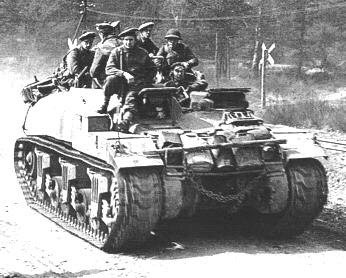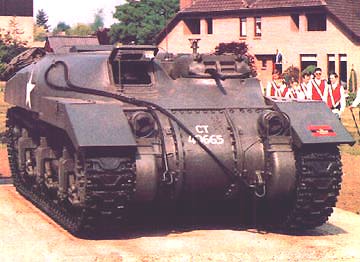
Try Amazon Fresh

Ram Kangaroo
The Ram Kangaroo was perhaps the second
most important conversion of the Ram tank after the Sexton
self-propelled gun. The idea of transporting infantry into action
in armoured carriers was first put into practise in WWII by 2nd
Canadian Corps in the push towards Falaise in the Summer of 1944.
Defrocked Priests were the original vehicles used in this role
but they had serious shortcomings in that their high sides made
mounting and dismounting the vehicle difficult for combat loaded
infantry and the vehicle itself provided no overhead protection
for its occupants.
Attention was drawn to the Ram tank as an alternative as they had
become largely surplus to Canadian needs with the adoption of the
Sherman series for the campaigns in the Mediterranean and
North-West Europe. The Ram would prove to have some of the same
faults as the defrocked Priests, but in a lesser degree. Entry
and exit would still prove difficult, but the armour protection
was much better and Rams were in plentiful supply for conversion
to the new role.
The initial proposal for conversion of the Ram to an armoured
personnel carrier forecast removing the turret and turret basket,
covering the drive shaft which ran through the hull, moving the
batteries to a sponson and installing a 14mm roof plate with
28" square hinged hatches to the turret ring of the hull. A
Number 19 wireless was to be fitted in the left front of the hull
and the .30 calibre MG was to be retained in the bow mount. It
was to be crewed by 2 and would carry 11 infantry. Benches were
never installed for the infantry occupants and photos illustrate
the fact that troops often rode on the outside of the vehicles
when not in action. They were forced to crouch inside the vehicle
for protection when moving into harms way.
The conversion was first ordered on 08 August 1944 but changes
soon followed in that the hull roof plate was eliminated as it
was thought to restrict exit from the vehicle, and perhaps most
importantly, it would delay the delivery of the converted
vehicles to the front line units.
The initial order for 56 Ram carriers was increased to 100 plus a
further 25 to be held in reserve. The order was increased to 162
for just 1st Canadian Army alone by 14 October 1944, and the
conversions continued as the carrier would eventually equip 1st
Canadian Armoured Personnel Carrier Regiment and the British 49th
Armoured Personnel Carrier Regiment, both of which operated under
Britain's 79th Armoured Division.
The conversions were applied to both the earlier style Rams which
mounted the auxiliary MG cupolas on the right hull front, and the
later version where it had been eliminated; although the later
versions were preferred.
The Ram carrier eventually became known as the Kangaroo and
proved to be a success in moving the infantry forward with
reduced casualties.
 |
(8)
Ram Kangaroo based on an earlier production Ram
equipped with the hull MG cupola.
 |
(60)
A restored Ram Kangaroo unveiled as a monument to
the 1st Canadian Armoured Personnel Carrier Regiment,
Mill, The Netherlands, 05 May 1995.
Return to CANADIAN ARMOUR PROFILES page
Site Map
© Chris Johnson, 1997